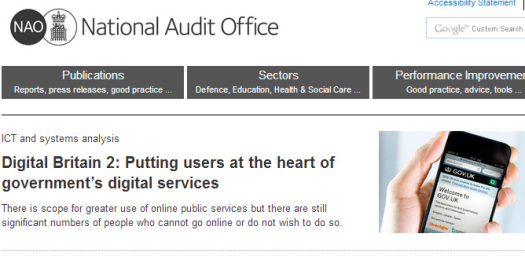Today the National Audit Office (NAO) published their Digital Britain Two report, examining the government’s digital by default strategy. In particular, the report took a close look at the strategy document we published last November, and assessed whether the evidence stacked up for taking the direction we’ve chosen.
The NAO’s views on what we’ve done are important, because they are both independent of government and responsible for checking that it spends public money wisely. Their reports are often very influential. In 2011 they published the Digital Britain One report (PDF, 556kB), which recommended five lessons that informed the newly created Government Digital Service (GDS).
The report includes findings from a large piece of independent fieldwork that the NAO commissioned to find out more about the UK’s online preferences and capabilities. They surveyed over 3,000 people and 130 businesses, gathering a wealth of interesting data. Happily for us, many of the findings tally very closely with the Digital Landscape Review, a survey that we ran to provide the evidence base for the Government Digital Strategy.
There’s other good news in this report. The NAO praises GDS’ firm leadership of the agenda, and the ambition of government’s digital plans. They also emphasise throughout the report that there is plenty of scope for greater use of online public services, and that most people and SMEs support this intention.
There are also some recommendations for things that GDS could look to improve upon. Improving public awareness - both of the public services that are available online and how we plan to help those who are offline - is something we can work on. They also suggest that our plans on assisted digital should seek to make more of the help those offline get from friends, family and colleagues, and make sure those plans are communicated effectively.
Overall, this report is a really positive sign we’re moving in the right direction. But it’s also a helpful reminder of the work we still need to do to support those who are less able to use online services.


3 comments
Comment by Jon Sundby posted on
Tanks! Again! Your strategy for sharing everythin is highly appreciated from us in Oslo, Norway!!
Comment by chrisconder posted on
Great work, but totally wasted until everyone has a fit for purpose connection that just works. Millions in the UK don't. MILLIONs not just a few rural people, many in towns on long line lengths can't get a good enough service to warrant paying for it and getting computers/phones/smartTvs etc. So they remain analogue. Keep up the good work, as it will be needed one day and we'll have a lot of catching up to do as other countries lay fibre networks and we just continue to let the incumbent leech the assets of a victorian phone network. We are getting left behind...
Comment by dmossesq posted on
The NAO report is available at http://www.nao.org.uk/wp-content/uploads/2013/03/10123-001-Digital-Britain-2-Book.pdf
Under the heading "Trust", the report includes the following:
QUOTE
4.9 To use online public services people need to be able to trust the government with the information they provide online. The Government Digital Strategy recognises that users of public services often find it hard to register for online services, and that it needs to offer a more straightforward, secure way to allow users to identify themselves online while preserving their privacy. Therefore there is an Identity Assurance Programme [IDAP] under way in GDS and we were told that this is to develop a framework to enable federated identity assurance to be adopted across government services.
4.10 The government also told us that this will involve creating a simple, trusted and secure new way for people and businesses to access government services, which will provide assurance to government that the right person is accessing their own personal information.
UNQUOTE
Without IDAP, there is no digital-by-default.
DWP were led to believe that IDAP would be "fully operational" for up to 21 million claimants of Universal Credit "from March 2013", https://online.contractsfinder.businesslink.gov.uk/Common/View%20Notice.aspx?NoticeId=797279
Here we are in March 2013. And the question the NAO almost ask is, where is IDAP?